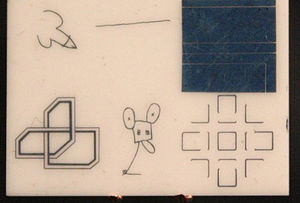- Moon Museum
-
Moon Museum 
Artist John Chamberlain, Forrest Myers, David Novros, Claes Oldenburg, Robert Rauschenberg, and Andy Warhol Year 1969 Type ceramic wafer Dimensions 1.9 cm × 1.3 cm (0.75 in × 0.5 in) Location Apollo 12 Intrepid landing module, Mare Cognitum The Moon Museum is a small ceramic wafer three-quarters of an inch by half an inch in size,[1] containing artworks by six prominent artists from the late 1960s. The artists with works in the "museum" are Robert Rauschenberg, David Novros, John Chamberlain, Claes Oldenburg, Forrest Myers, and Andy Warhol.[1]
This wafer was supposedly covertly attached to a leg of the Intrepid landing module, and subsequently left on the moon during Apollo 12.[2] The moon museum is considered the first Space Art object.[3] While it is impossible to tell if the Moon Museum is actually on the moon without sending another mission to look, many other personal effects were smuggled onto the Apollo 12 lander and hidden in the layers of gold blankets that wrapped parts of the spacecraft.[1]
Contents
History
 Image of the Moon Museum from the original New York Times article
Image of the Moon Museum from the original New York Times article
The concept for the Moon Museum was brainstormed by Forrest "Frosty" Myers. He stated that "My idea was to get six great artists together and make a tiny little museum that would be on the moon."[1] Myers attempted several times to get his project sanctioned by NASA. He claims the agency gave him the runaround and, Myers states, "They never said no, I just could not get them to say anything."[1] Instead of going through the official channels he was forced to take the back route and try to smuggle it on board.
Myers contacted Experiments in Art and Technology (E.A.T.), a non-profit group that was linking artists with engineers to create new works. Through E.A.T., Myers was introduced to some scientists from Bell Laboratories, specifically Fred Waldhauer. Using techniques normally used to produce telephone circuits, the scientists etched the drawings Myers had gathered onto small ceramic wafers. Either 16 or 20 of these wafers were created,[1] with one going on the lunar lander and the rest, copies of the original, handed out to the artists and others involved in the project.[4]
When NASA dithered whether the museum would be allowed onto the module, Waldhauer devised another plan. Waldhauer knew a Grumman Aircraft engineer who was working on the Apollo 12 lander module, and he proved willing to place the museum on it.[5] Myers asked Waldhauer how he would know if the museum actually made it onto the lander, and was told that the person who worked for Grumman would send him a telegram when the wafer was in place. At 3:35 p.m. on November 12, 1969, less than two days before Apollo 12 took off, Myers received a telegram at his house from Cape Canaveral, Florida stating "YOUR ON' A.O.K. ALL SYSTEMS GO," and signed "JOHN F."[1]
The existence of the work was not revealed until Myers informed The New York Times which ran an article on the story two days after Apollo 12 left the moon and two days before they splashed down in the Pacific Ocean.[6]
Artworks
 Supposedly one of the 15 or 19 copies of the Moon Museum.
Supposedly one of the 15 or 19 copies of the Moon Museum.
Artwork Placement Warhol Rauschenberg Novros Myers Oldenberg Chamberlain There are six artworks located on the ceramic tile, each one in black and white only. Starting in the top center is a single line by Robert Rauschenberg. To its right is a black square with thin white lines intersecting, resembling a piece of circuitry, by David Novros. Below it is John Chamberlain's contribution, a template pattern which also resembles circuitry. In the lower middle is a geometric variation on Mickey Mouse, by Claes Oldenberg, a popular motif for the artist at that time. Myers created the work in the lower left, a computer-generated drawing of a "linked symbol" called "Interconnection". Finally, the last drawing in the upper left is by Andy Warhol. He created a stylized version of his initials which, when viewed at certain angles, can appear as a rocket ship or a penis.[1][2] "He was being the terrible bad boy." says Myers.[1] Warhol's work is covered up by a thumb in the image often associated with the Moon Museum, but other images with the drawing visible can be found.[6]
Both John Chamberlain and Claes Oldenberg have confirmed through representatives that they did in fact take part in the moon museum and contributed drawings to the effort.[4]
See also
References
- ^ a b c d e f g h i Who is John F.?, History Detectives, PBS, Season 8, Episode 1, June 7, 2010. Accessed July 14, 2010
- ^ a b Secret Museum On The Moon’s Surface. UCSD Libraries. March 1, 2008. Accessed July 14, 2010
- ^ The Moon Museum: First Space Art Object Lands at Tampa Museum of Art. Tampa Museum of Art June 18 - August 1, 2010. Accessed July 15, 2010.
- ^ a b Moye, David. Warhol in Space: Apollo 12 Secretly Carried Art to the Moon. AOL news. June 17, 2010, Accessed July 14, 2010.
- ^ PBS' HISTORY DETECTIVES PUTS A QUESTION TO THE NATION: IS ANDY WARHOL’S ART ON THE MOON?. PBS. June 7, 2010. Accessed July 14, 2010
- ^ a b Holy ^%$&! Man Smuggles Art To The &%#$ing Moon! Greg.com. February 8, 2008. Accessed July 14, 2010
External links
Categories:
Wikimedia Foundation. 2010.
